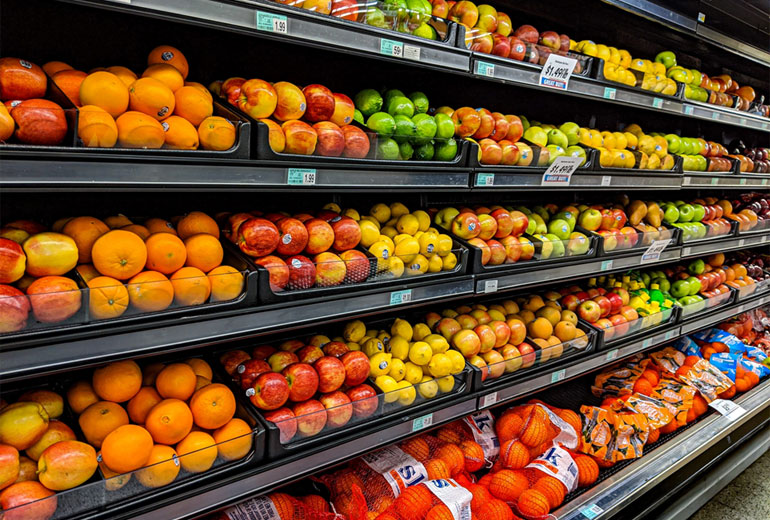
Image Credit: Unsplash @_gemmajade
The coronavirus pandemic has accelerated the transition to online grocery shopping, a significant surge that the e-commerce industry had never seen before.
Reports from summer 2020 show that online grocery sales grew 92% year-on-year in the four weeks up to 12 July 2020, with one in four UK shoppers choosing online groceries at least once a week.
In this knowledge post, we look at the substantial growth in online grocery shopping and its impact on the e-commerce industry. We’ll then give some tips on how supermarkets and online retailers prepare for a time like this.
According to a Mintel Consumer Research Study, the online grocery shopping sector is booming, with the market set to be worth £17.9 billion by 2024, growing by 41% over the five-year period. The analysis reported that an unprecedented number of shoppers are swapping traditional in-store grocery shopping with online purchases since the covid-19 outbreak. Experts believe this new consumer habit could become permanent.
When the outbreak began, 7% of UK consumers increased their online shopping purchases. Less than 2 months after social distancing measures were introduced, 36% of UK consumers had swapped to online for both food and non-food essentials. Additionally, Mintel’s findings show that 50% of UK consumers have begun to reduce the amount of time they spend in-store, while a further 9% have increased their use of click-and-collect.
Millions of UK shoppers have been doing their regular supermarket shops online since the start of the coronavirus pandemic and one of the main motives appears to be the fear of being infected with Covid-19 whilst shopping in-store. Online grocery shopping has been particularly in demand from more vulnerable customers, elderly people and families who want to avoid public places and limit the chances of contracting the virus.
Research conducted by UK supermarket Waitrose showed that the growth in online grocery shopping amounts to up to 60% more compared to last year. The research showed that one in four consumers now buy food and essentials at least once a week online. Additionally, over three-quarters of UK shoppers order some household goods online.
Reports from the Guardian also show that the number of over 55s who do some online food shopping grew by 27% compared to 2019. This is another confirmation that more people are shopping online to avoid contact with other people in-store and the risk of being exposed to the virus.
With the unprecedented growth in online grocery shopping, it’s fair to say that the future of e-commerce is promising.
BOPIS and BOPIL
The shift from traditional in-store grocery shopping to online grocery shopping is with no doubt the safest option for many UK shoppers. For others, it’s also the quickest and most convenient way to purchase all their essentials. However, for e-commerce businesses offering their services online more frequently than before, it can become more expensive than profitable, especially considering the high demand.
One common question in relation to this issue is: how do we make online grocery shopping efficient while making profit? BOPIS and BOPIL offer a solution to this in some way.
BOPIS, which stands for buy-online-pickup-in-store, is helping supermarkets and e-commerce businesses cut costs while still ensuring the safety of customers and store workers. When using the BOPIS service, costs for delivery drivers, vans and fuel can be cut, driving time is also cut, bringing more profit to the business while offering a seamless shopping experience.
Similarly, BOPIL, meaning buy-online-pickup-in-locker, offers to shoppers the option to collect their online grocery orders from a safe locker. This simplified process makes life easier for both the retailer and the consumer.
Same day delivery
More and more supermarkets are now able to offer same day and next day delivery options. This is again another advancement that was not exactly common in the past. One benefit of a same day delivery option for grocery shopping is that the reduced transition time helps with food conservation. Supermarkets can keep food and perishable items fresh by delivering them to their customers on the same day. It’s quick, innovative and convenient.
In some way, same day delivery services can be seen as a customer retention strategy; when customers know they can rely on a retailer’s fast delivery option for a last-minute shop, they are more likely to return due to the excellent service offered.
There are many ways through which businesses can ensure that they are fully prepared to meet the new soon-to-become- permanent consumer habit.
Website appearance
Your e-commerce site should be impeccable at a time like this. There are a few areas you should ensure are optimised to boost your overall performance.
Product Feeds
As we mentioned in the Google Shopping in lockdown knowledge post, people are shopping more online and this is a great opportunity that you shouldn’t miss. Good performance begins with fully optimised product feeds.
You can see how you are performing in the Merchant Centre. Here, your most important data such as Clicks, Impressions, Click-through Rate, Conversions, Revenue and ROAS will be stored, giving you a clear idea on what is working well for the business and what needs improvement. Keep this monitored to ensure that you are at your fullest digital potential.
If you’re unsure how to get your e-commerce prepared for a time like this, contact us today and we’ll go through a free demo to explain your possibilities.
Monthly Subscription